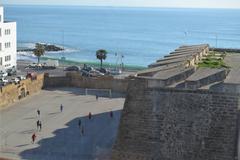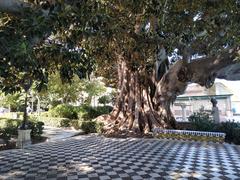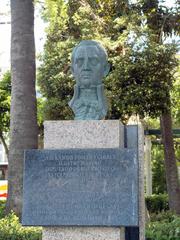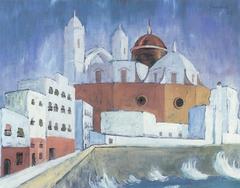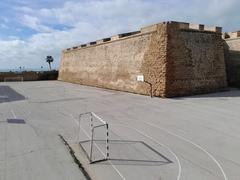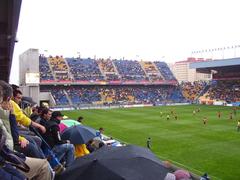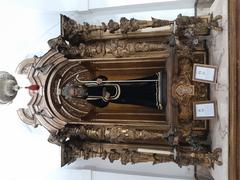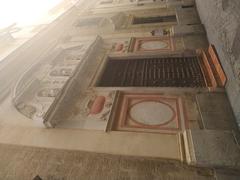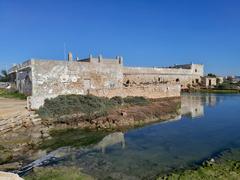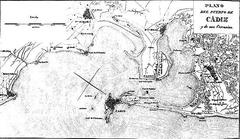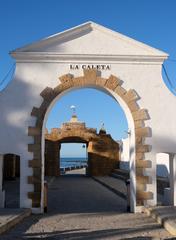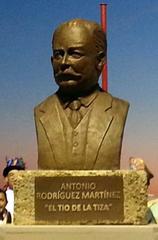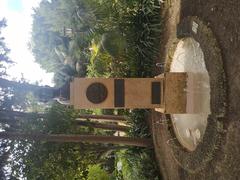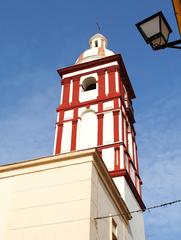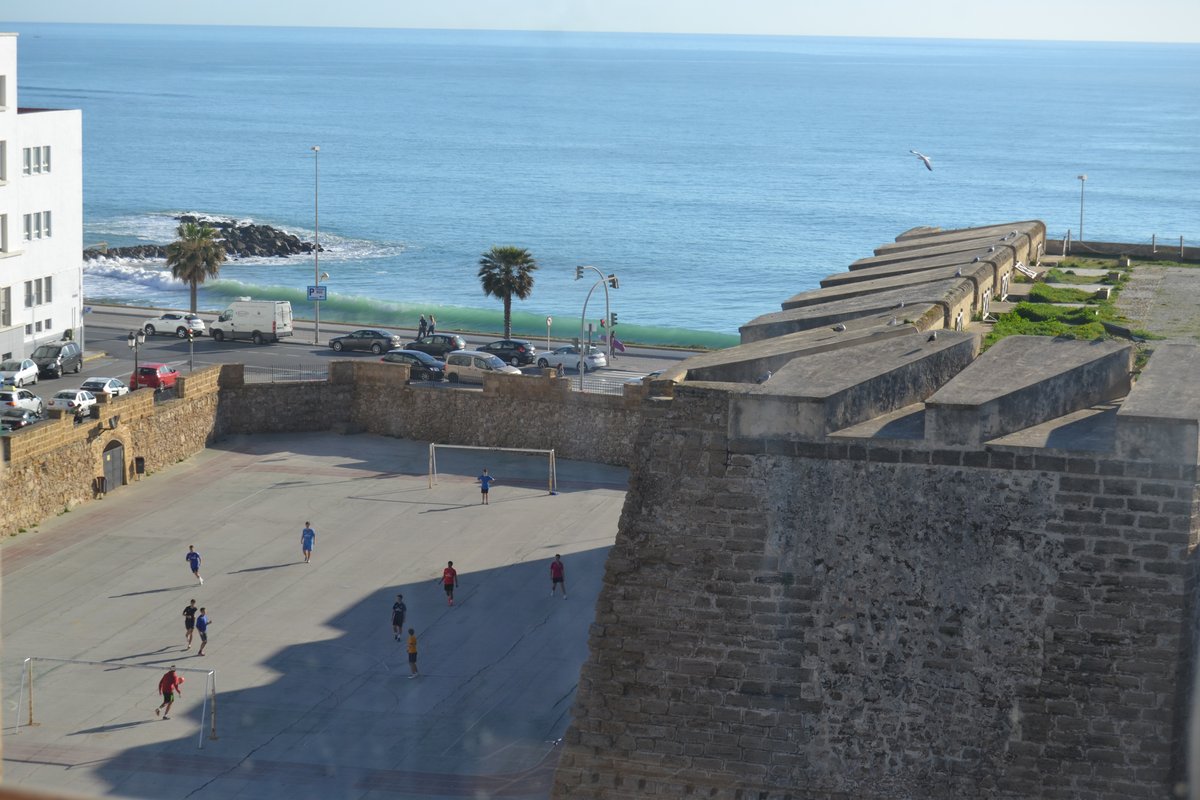
Baluarte de San Roque: Visiting Hours, Tickets, and Comprehensive Guide to Cádiz’s Historic Bastion
Date: 14/06/2025
Introduction
The Baluarte de San Roque is an enduring symbol of Cádiz’s military ingenuity and cultural dynamism. Situated within the historic heart of Cádiz, Spain, this 18th-century bastion was integral to the formidable “Frente de Tierra” fortifications designed to protect the city from landward invasions. Today, the Baluarte seamlessly blends its martial past with a vibrant present, serving as a cultural venue and a testament to Cádiz’s layered history. This guide provides essential information for planning your visit—including opening hours, tickets, accessibility, and nearby attractions—while offering deep insight into the bastion’s historical and contemporary significance.
Table of Contents
- Historical Overview
- Architectural Highlights
- Visitor Information
- Special Events and Guided Tours
- Frequently Asked Questions (FAQs)
- Cultural and Community Significance
- Economic and Tourism Impact
- Visual Resources
- Sources and Further Reading
Historical Overview
Early Defenses and Construction
Cádiz’s strategic location on a narrow isthmus rendered it vulnerable to attack, prompting the construction of advanced fortifications as early as the 16th century. By 1529, the original medieval walls were deemed inadequate, leading to the development of new defensive structures along the land bridge connecting Cádiz to the mainland. These early efforts were challenged by environmental factors like strong Levante winds, which weakened the walls and contributed to catastrophic breaches, such as the Anglo-Dutch raid of 1596 (miscastillos.blog).
Evolution of Cádiz’s Fortifications
In response to military failures, Juan Bautista Calvi, a renowned Italian engineer, was commissioned to redesign Cádiz’s defenses in 1554. His plan introduced bastioned fortifications, including two principal bastions: Benavides (later Santa Elena) and San Roque. These were connected by a curtain wall with a central gate, forming the nucleus of what would become the “Frente de Tierra” (miscastillos.blog).
While the construction of these bastions began in the late 16th century, progress was slow, and the defensive network was repeatedly expanded and improved over the next century, notably with the addition of moats and outer works in the mid-17th century.
The 18th Century: Golden Age and Strategic Importance
The 18th century marked the zenith of Cádiz’s defensive architecture, driven by the city’s rise as the principal port for Spanish-American trade following the transfer of the Casa de Contratación from Seville in 1717. Engineers like Ignacio Sala and Próspero Verboom, inspired by the bastioned fortification theories of Vauban, oversaw the completion of the “Frente de Tierra,” including the definitive realization of the Baluarte de San Roque in 1754 (defensasbahiadecadiz.com).
Constructed from distinctive “piedra ostionera” (oyster stone), the Baluarte de San Roque featured a triangular ground plan and was strategically positioned to defend the ocean-facing approaches to the Puerta de Tierra—the grand entrance to Cádiz’s historic center. The bastion’s name honors a former hermitage dedicated to Saint Roch, underlining the site’s multifaceted significance (defensasbahiadecadiz.com).
19th–20th Century Transformations
With changes in warfare and urban expansion, the military relevance of Cádiz’s fortifications declined in the 19th century. The Baluarte de San Roque and nearby barracks were gradually repurposed for civic uses, including government offices and public facilities. The 1940s saw significant alterations: new roadways breached the defensive walls, and portions of the bastion were demolished to accommodate modern traffic, further integrating the structure into the urban landscape (diariodecadiz.es).
Contemporary Role and Preservation
Today, the Baluarte de San Roque is protected as a “Bien de Interés Cultural” under Spanish heritage law (castillosnet.org), and it has been adaptively reused as a venue for art exhibitions, cultural events, and community programs. The Galería de Arte Baluarte de San Roque, inaugurated in 2014, occupies two vaulted chambers within the bastion, hosting exhibitions that frequently explore European and Moroccan cultural themes (guiadecadiz.com). Although the gallery may close temporarily for maintenance or programming changes, the bastion remains an accessible and evocative feature of Cádiz’s urban and cultural fabric.
Architectural Highlights
The Baluarte de San Roque exemplifies robust 18th-century military design, with a rectangular plan, two-story elevation, and thick oyster stone walls. Notable features include:
- Vaulted Chambers: Adapted as exhibition spaces with modern lighting and climate control.
- Panoramic Windows: Offering striking views of Cádiz’s maritime edge.
- Moat Remnants: Visible near the Columela Institute, reflecting the original defensive landscape.
- Accessibility Upgrades: Elevators and ramps provide barrier-free access.
The bastion’s integration into the Puerta de Tierra complex, alongside the Baluarte de Santa Elena and the monumental city gate designed by José Barnola, underscores its centrality to Cádiz’s historic defenses (miscastillos.blog).
Visitor Information
Visiting Hours
- Standard Opening: Tuesday to Sunday, 10:00 AM – 6:00 PM
- Closed: Mondays and public holidays
- Note: Hours may vary due to special events or seasonal schedules. Always verify on the official Cádiz tourism website before visiting.
Tickets and Entry
- Admission: Free to the public.
- Special Exhibitions/Guided Tours: May require advance booking and a modest fee.
Accessibility
- Wheelchair Access: Ramps and elevators ensure accessibility to most public areas.
- Facilities: Modern restrooms, exhibition spaces with audiovisual systems, and clear signage.
- Assistance: Contact the tourism office in advance for specific needs.
Directions and Transportation
- Location: Avenida Fernández Ladreda, adjacent to the Puerta de Tierra, Cádiz.
- On Foot: 10–15 minutes from Cádiz Cathedral.
- Public Transport: City buses serving the historic center stop nearby.
- By Car: Limited parking available; public transportation is recommended during peak periods.
- Map: Available on the official tourism website.
Facilities
- Exhibition Halls: Spacious, climate-controlled, and equipped for contemporary art and cultural events.
- Restrooms: Onsite and nearby.
- Café: Not onsite, but numerous options are available in the immediate vicinity.
Nearby Attractions
- Puerta de Tierra: Main city gate and architectural landmark.
- Cádiz Cathedral: Iconic Baroque and neoclassical structure.
- Castillo de San Sebastián & Castillo de Santa Catalina: Additional historic fortifications.
- Plaza de España & Old Town: Lively squares, gardens, and shopping streets.
Travel Tips
- Wear comfortable footwear due to uneven stone flooring.
- Bring water and sun protection, especially in summer.
- Check for current exhibitions or guided tours.
- Photography is allowed, but flash and tripods may be restricted during exhibitions.
Special Events and Guided Tours
The Baluarte de San Roque regularly hosts art exhibitions, lectures, workshops, and cultural events—often focusing on intercultural dialogue between Europe and Morocco (guiadecadiz.com). Guided tours are available seasonally or by prior arrangement. For up-to-date information, consult La Ventana del Arte or the official tourism site.
Frequently Asked Questions (FAQs)
Q: What are the Baluarte de San Roque visiting hours?
A: Typically Tuesday to Sunday, 10:00 AM to 6:00 PM; closed Mondays and public holidays. Hours may change for special events.
Q: Is there an entry fee?
A: Admission is generally free; special events may have a fee.
Q: Is the site accessible for visitors with disabilities?
A: Yes, with ramps and elevators in public areas.
Q: Are guided tours available?
A: Yes, but scheduling varies. Contact the tourism office or gallery in advance.
Q: Can I take photos?
A: Photography is allowed, but restrictions may apply during exhibitions.
Cultural and Community Significance
The Baluarte de San Roque is not merely an architectural relic; it is woven into Cádiz’s urban life and identity. Its evolution from a defensive barrier to a hub for art, education, and community gatherings illustrates Cádiz’s adaptive spirit (hitosdecadiz.blogspot.com). The site’s vaults have housed the Museo Litográfico and served as venues for major festivals such as Carnival, reinforcing its role as a communal gathering point.
The surrounding moats and courtyards have been converted into gardens and recreational spaces, fostering social inclusion and enhancing urban quality of life.
Economic and Tourism Impact
As a flagship of Cádiz’s heritage tourism, the Baluarte de San Roque attracts both locals and over a million annual visitors to the city (Oway Tours Guide). Its continued restoration and cultural programming stimulate the local economy, support artisan businesses, and ensure sustainable development through heritage management (Elmira Article).
Visual Resources
- Virtual Tours and Images: Find high-quality images and virtual tours on the official Cádiz tourism website and La Ventana del Arte.
- Descriptive Alt Text: All visuals are accompanied by alt text for accessibility and SEO.
Sources and Further Reading
- Defensas Costa Andaluza: El Frente de Tierra de Cádiz – miscastillos.blog
- Baluarte de San Roque – castillosnet.org
- Galería de Arte Baluarte de San Roque – guiadecadiz.com
- Contemporary Use and Conservation – diariodecadiz.es
- Puertas de Tierra: Frente Defensivo – hitosdecadiz.blogspot.com
- Galería de Arte Baluarte de San Roque – turismo.cadiz.es
- Galería de Arte Baluarte de San Roque – La Ventana del Arte
- Monumentos Cádiz: La Puerta de la Tierra – Oway Tours Guide
- Así lucirá renovada la fuente de las Puertas de Tierra de Cádiz – Elmira Article
Plan Your Visit
Experience Cádiz’s remarkable history and lively culture at the Baluarte de San Roque—a site where military heritage meets contemporary creativity. For the most current information, always consult the official Cádiz tourism website or download the Audiala app for guides, events, and travel tips.
